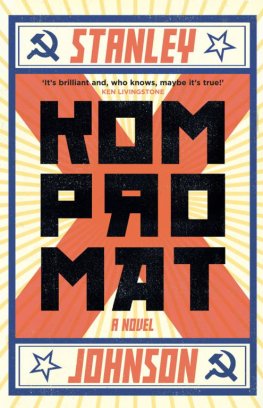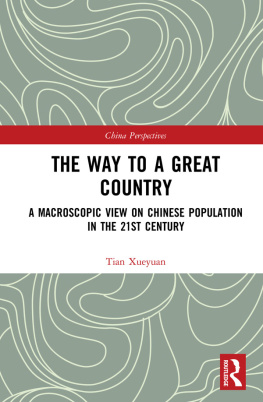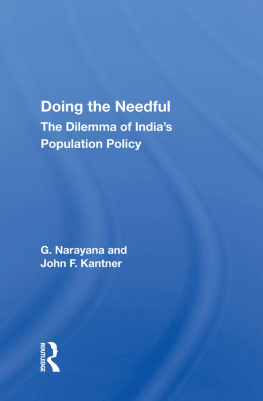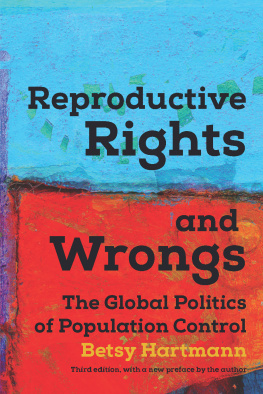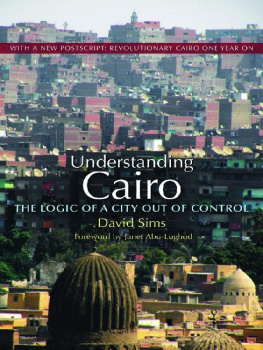HEALTH AND POPULATION
Volume 3
The Politics of Population
Cairo 1994
Full list of titles in the set
HEALTH AND POPULATION
Volume 1: Coping with Population Challenges
Volume 2: The Future Population of the World
Volume 3: The Politics of Population
Volume 4: Population and Strategies for National Sustainable Development
Volume 5: Health and Climate Change
Volume 6: The Therapeutic Nightmare
Volume 7: Health and Environmental Impact Assessment
Volume 8: Birth Without Doctors

First published in 1995
This edition first published in 2009 by Earthscan
Copyright Stanley Johnson, 1995
All rights reserved
ISBN 978-1-84971-033-6 (Volume 3)
ISBN 978-1-84971-030-5 (Health and Population set)
ISBN 978-1-84407-930-8 (Earthscan Library Collection)
ISBN 978-1-134-06617-9 (epub)
For a full list of publications please contact:
Earthscan
Dunstan House
14a St Cross Street
London EC1 N 8XA, UK ]
Tel:+44 (0)20 7841 1930
Fax:+44(0)20 7242 1474
Email:
Web: www.earthscan.co.uk
22883 Quicksilver Drive, Sterling, VA 201 66-2012, USA
Earthscan publishes in association with the International Institute for
Environment and Development
A catalogue record for this book is available from the British Library
Library of Congress Cataloging-in-Publication Data has been applied for
Publishers note
The publisher has made every effort to ensure the quality of this reprint, but ]
points out that some imperfections in the original copies may be apparent.
At Earthscan we strive to minimize our environmental impacts and carbon
footprint through reducing waste, recycling and offsetting our C02
emissions, including those created through publication of this book. For
more details of our environmental policy, see www.earthscan.co.uk.
This book was printed in the UK by CPI Antony Rowe.

The paper used is FSC certified.


First published in the UK in 1995 by
Earthscan Publications Limited
Copyright Stanley Johnson, 1995
All rights reserved
A catalogue record for this book is available from the British Library
ISBN 1 85383 297 9
Typeset by Photoprint, Torquay, Devon
Cover design by Dominic Banner
Picture research by Brooks Krikler
Published with the generous support of the
United Nations Population Fund (UNFPA)
For a full list of publications please contact:
Earthscan Publications Limited
120 Pentonville Road
London Nl9JN
Tel: 0171 278 0433
Fax: 0171 278 1142
Earthscan is an editorially independent subsidiary of Kogan Page Limited
and publishes in association with WWF-UK and the International Institute
for Environment and Development.
Contents
, Gender Equality, Equity and Empowerment of Women
It is easy to be cynical. Nowadays, one mega-conference seems to succeed another. The Earth Summit, as the United Nations Conference on Environment and Development (UNCED) held in Rio de Janeiro, Brazil, in June 1992 was generally called, seemed at the time to be the conference to end all conferences. Like the Congress of Vienna, the Earth Summit aimed to set up a new world order. This time, however, the focus would not be on the balance of power, on diplomatic alliances and rivalries, but on the new verities, the new imperatives governing the way the world should conduct its affairs, particularly those having to do with the protection of the environment and the pursuit of higher living standards for the mass of the worlds poor. The message was interdependence, not independence.
One hundred and seventy five nations were represented at Rio and over a hundred heads of state attended. There were 1500 officially accredited non-governmental organisations, as well as 7000 journalists. In Agenda 21 UNCED adopted a 600-page tome which seemed to cover every subject under the sun. The whole of life was there. As the weary participants made their way home after the two-week session, they could have been forgiven for supposing that the massive process of intergovernmental consultation and negotiation which had preceded the conference, which had continued in Rio itself and which ultimately had resulted in some hard-won international agreements, of which Agenda 21 was probably the most important and certainly the most voluminous, had surely obviated the need for another mammoth meeting at least for the foreseeable future.
Yet, as one great wave crashed on to the beach, new waves were curling their crests behind. Even as the UNCED negotiations proceeded, preparations were being made for further mega-conferences. The UN Conference on Human Rights would take place in Vienna in 1993 and a year later the International Conference on Population and Development, or ICPD, would be held in Cairo. (The decision to hold the ICPD had indeed been taken by the United Nations Economic and Social Council, ECOSOC, as long ago as July 1989. By the time of the Earth Summit, the first meeting of the ICPD Preparatory Committee had already taken place and others were planned.)
Beyond the ICPD loomed the Social Summit to be held in Copenhagen in March 1995 and beyond that lay the great womens conference planned for Beijing in August of the same year, with yet another meeting, known as Habitat 2, already being organised for Istanbul in 1996. As the poet William Wordsworth so aptly put it, hills peep oer hills and Alps on Alps arise.
Given this perspective, given the fact that, among all the reams of paper covered with ink at these UN gatherings, one will never find a single binding commitment, a single justiciable paragraph or even sentence, a degree of cynicism seems inevitable and forgivable. If the output of these mega-conferences can be considered law at all, it is certainly the softest of soft law. Those who participate in these UN-sponsored gatherings certainly take them and themselves seriously one only has to go into a meeting room when one of these mega-conferences is in session and watch the solemn-suited rows of delegates with their name cards and headphones to realise just how serious, how portentous, how self-deluding the proceedings can sometimes be. For the outsider, it can seem more than a trifle unreal. The airconditioned meeting rooms in New York or Geneva, Rio, Cairo, Copenhagen, Beijing or wherever are about as far from the village pump as you can get.
Why then a book about the Cairo population conference? What distinguishes the ICPD from the host of other gatherings? What was specially memorable about those nine days in September 1995? Now that the dust has settled along the banks of the Nile, can it plausibly be argued that the Cairo population summit represented as some of the more enthusiastic participants have argued a quantum leap forward in the way the population issue is to be handled from now on?


